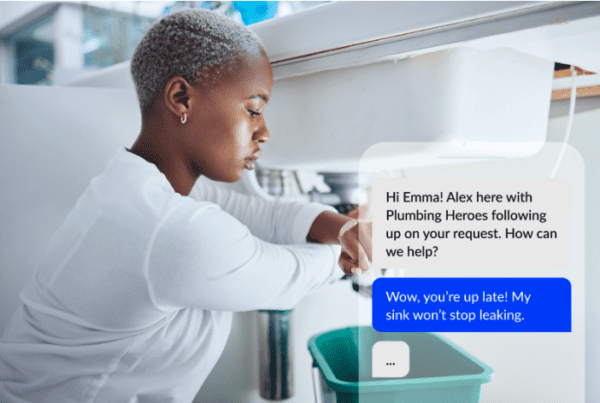Are you generating plenty of leads, but failing to convert many of these potential customers into actual customers?
You might be experiencing what we call the lead conversion gap.
Many companies spend tons of money and time on lead generation, but leave money on the table when trying to convert leads into customers.
After the investment it takes to find prospects who are a great fit, and then get their attention, it can be very disheartening when the deals fail to close.
Prevent lost opportunities, steer clear of common pitfalls, and convert more leads into customers with these five strategies.
In this blog, we’ll discuss tips to enhance lead conversion and turn almost-customers into paying customers.
What is lead conversion?
Lead conversion can mean multiple things: it could mean a lead became a lead, the lead has qualified, or that the lead has become a customer.
Most often, lead conversion is the process of turning your hard-earned leads into paying customers. That is the definition we are using for the purposes of this blog.
Lead generation alone doesn’t guarantee sales success; if your lead conversion rate is lackluster, you could be wasting time and money on lead generation efforts.
When a potential customer fills out a contact form with your business, you’ve generated a lead—now it’s time to convert them. This process can include both sales and marketing.
Usually, the lead will then go through a qualification process with both marketing and sales criteria. Sales can then reach out to the lead in order to try and make the sale.
How to calculate lead conversion rate
To calculate your current lead conversion rate (LCR), divide your total number of leads generated by the number of leads that ultimately bought. These numbers should both be from the same time period.
For example, say you are calculating LCR for September, and you generated 1,000 leads in that month, and made 200 sales in September. Your September LCR would be 20%.
Common mistakes in lead conversion
The lead conversion gap is where leads go to (metaphorically) die. Though you’ve successfully gained their interest, generating the lead, you’ve failed to convert the lead into a customer.
There are a few ways that the lead conversion process often goes wrong, creating a lead conversion gap:
- Companies don’t reach out fast enough after the lead is generated.
- Sales teams don’t follow up enough with the lead.
- Marketing and sales teams don’t use multiple channels when reaching out.
- Companies contact customers on their terms rather than what the customer wants.
- Companies spend money on the wrong lead sources.
Let’s go over five tips to avoid these common mistakes and convert leads into customers with a more modernized and effective approach.
Immediate outreach
In today’s competitive market, it’s vital to take swift action—especially when you’ve piqued the interest of someone in your target audience.
Speed-to-lead has never been more important:
- Leads are 21x more likely to convert if they are contacted within 5 minutes of filling out a form.
- You’re 100x more likely to get in touch with a lead 5 minutes after they submit an inquiry than 30 minutes after.
- Lead conversions are 391% higher if you call within a minute of an online inquiry being submitted. Waiting just one hour after drops that to 36%.
- 78% of customers will choose the organization that contacts them first.
Unless you’re the only one on Earth selling your product, if you’re not reaching out quick enough, they have plenty of other choices at their fingertips.
Every minute that goes by, the lead will continue to lose interest. It’s increasingly vital that companies are reaching out to their leads right as they’ve expressed interest.
Fast, well-executed lead outreach can supercharge lead conversion rates and while helping you outshine competitors who may still be clinging to slower, outdated processes.
If you want to maximize conversions, being slow with outreach is basically leaving money on the table.
Consistent follow-up
If you want to convert more leads into customers, persistence is key.
For marketing teams, follow-up via lead nurture is vital to boosting conversion rates.
For leads that are not ready to buy, lead nurture provides them with helpful resources and information over time. Nurture aims to provide value while reminding the lead that your company exists.
This helps to ensure that these leads don’t forget about your company or offerings—so when they’re ready to buy, you remain top-of-mind.
For sales teams, direct follow-up with leads can substantially increase conversion rates.
If the lead does not reply to initial outreach, don’t give up. While 80% of sales are made after five or more calls, the majority of salespeople will give up after only one or two attempts.
People are busy, and the majority of sales outreach is ignored. However, once you get through, you’re talking to a potential customer—who you wouldn’t be speaking to if you gave up early.
Though it can be difficult to persist in contact despite silence on the other end, it will help you convert more leads into customers.
Omnichannel communications
Embracing omnichannel communications is a concrete strategy to amplify return on lead generation investment.
When a brand communicates with leads via their preferred channels, they’re meeting customers in their comfort zones, enhancing the ease and likeliness of a sale.
While emails are an easy and effective way to contact leads, the average professional receives 120 new emails per day—meaning your emails will often get lost in the noise.
Using multiple channels increases your chances of connecting with customers, and eventually converting them.
For example, some people want to talk on the phone, while others will almost never pick up.
Depending on your product and industry, being available on social media may also help you reach your customers where they are, boosting conversion rates.
Texting, on the other hand, has become most consumers’ highest-preferred channel. While email open rates are around 20%, texts are almost always read (98% open rate).
Adding two-way texting to your omnichannel communication strategy can help boost engagement rates, connecting you with more leads, faster. Smart businesses recognize this and are not shy about integrating SMS tools to optimize conversion rates.

Meeting on customers’ time and terms
Thinking about the importance of immediate outreach, it’s clear that companies must be available exactly when the customer is ready—not an hour later.
In a competitive market, businesses must align their communications with the customer’s preferred schedule and platform.
People are often busy during the day with work, school, kids, and appointments.
By being available outside of the proverbial 9-to-5 window, a brand demonstrates respect for the customer’s time and needs, which can boost conversion rates.
Businesses adept at lead conversion know they must adapt to varied schedules. Your readiness should match their readiness at any time.
In addition, the concept of meeting customer preferences goes back to the channel. Again, ensure that you are meeting your leads on the right channels at the right times.
Lead source tracking
Lead conversion heavily depends on lead quality, which in turn can depend on the lead source.
Lead sources often have differing average conversion rates. For example, Google Ads leads might convert at 3%, while leads from organic traffic convert at 10%.
It’s vital to track these to ensure that you’re spending your lead generation budget in the right places.
If you are struggling to convert leads into customers, try auditing your lead sources for conversion rates.
You can then increase spend on high-converting lead sources and reduce spend on sources that aren’t delivering quite as well.
To practically track conversion rates by lead source, there are many tools you can use to evaluate lead sources. Google Analytics is a great place to start.
Lead conversion tools like Verse can help you see exactly how each lead source is performing, from engagement rate to conversion rates for each.

Key takeaways: How to convert leads into customers
As a recap, here are the five essential tips to help enhance your conversion rates:
- Reach out immediately: Act swiftly to contact leads—doing so within 5 minutes increases conversion likelihood significantly. Speed matters; the faster you reach out, the better your chances of converting the lead.
- Follow up consistently: Don’t give up after one or two attempts; many sales occur after multiple sales follow-ups. For marketing, nurturing leads through ongoing, helpful communication keeps your brand top-of-mind.
- Use an omnichannel approach: Use various channels to connect with leads, meeting them where they are. Incorporating SMS can enhance engagement and boost conversion rates.
- Meet customers on their terms: Be available outside typical business hours and adapt to your leads’ preferred schedules and platforms. This demonstrates respect for their time and increases the likelihood of conversion.
- Track lead source performance: Monitor the conversion rate of each of your lead sources to optimize your conversion rates and spend. By identifying high-converting channels, you can allocate resources more effectively and improve overall conversion rates.
By implementing these strategies, you can modernize your approach to lead conversion and ultimately drive greater business success.
Supercharge lead conversion with Verse
At Verse, we understand the critical importance of timely and effective lead engagement.
That’s why we combine our team of human concierges and conversational AI for instant response for every lead via text message.

Verse helps you boost conversion rates with:
- 24/7 instant response via SMS to ensure that every lead is contacted immediately, maximizing the chances of conversion right when interest is high.
- Consistent follow-up for every lead, providing customizable, ongoing outreach and lead nurture for up to six months.
- Automatic lead qualification to give your team time back to focus on high-quality leads, while efficiently nurturing those who may need more time.
- Omnichannel communications via text, phone call, and email with optional live call transfers to your team.
- Robust lead source tracking and analytics empower you to evaluate the performance of various channels, enabling you to optimize your budget and strategies effectively.
See what Verse can do for you—calculate your personalized ROI with our new self-serve calculators.


